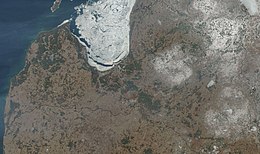 | |
| Continent | Europe |
|---|---|
| Region | Northern Europe |
| Coordinates | 57°00′N 25°00′E / 57.000°N 25.000°E |
| Area | |
| • Total | 64,559 km2 (24,926 sq mi) |
| • Land | 96.38% |
| • Water | 3.62% |
| Coastline | 498 km (309 mi) |
| Borders | Total land borders: 1,382 km (859 mi) |
| Highest point | Gaizinkalns 312 m (1,024 ft) |
| Lowest point | Baltic Sea 0 meters |
| Longest river | Gauja River 452 km (281 mi) |
| Largest lake | Lake Lubāns 25 km2 (9.7 sq mi) |
| Exclusive economic zone | 28,452 km2 (10,985 sq mi) |

Latvia lies on the eastern shores of the Baltic Sea on the level northwestern part of the rising East European platform, between Estonia and Lithuania. About 98% of the country lies under 200 m (656 ft) elevation. With the exception of the coastal plains, the ice age divided Latvia into three main regions: the morainic Western and Eastern uplands and the Middle lowlands. Latvia holds over 12,000 rivers, only 17 of which are longer than 100 km (60 mi), and over 3,000 small lakes, most of which are eutrophic. The major rivers include the Daugava, the Lielupe, the Gauja, the Venta and the Salaca. Woodlands cover around 52%[1] of the country (Pine – 34%, Spruce – 18%, Birch – 30%).[2] Other than peat, dolomite, and limestone, natural resources are scarce. Latvia has 504 km (313 mi) of sandy coastline, and the ports of Liepāja and Ventspils provide important warm-water harbors for the Baltic coast.
Latvia is a small country with a land size of 64,559 km2 (24,926 sq mi). However, it is larger than many other European countries (Albania, Belgium, Bosnia and Herzegovina, Croatia, Cyprus, Denmark, Estonia, Luxembourg, North Macedonia, Malta, Montenegro, Netherlands, Slovakia, Slovenia or Switzerland). Its strategic location has instigated many wars between rival powers on its territory. As recently as 1944, the USSR granted Russia the Abrene region, which Latvia contested after the dissolution of the Soviet Union.